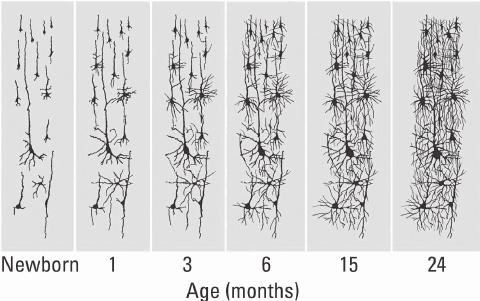
Do you find Figure 1 as exciting and revealing as I do? Broca’s area, a part of the temporal lobe, usually in the left hemisphere, was identified by Pierre Paul Broca as essential for speech production.
In the leftmost column of Figure 1, we see thirteen or fourteen neurons existing in the newborn, none connected to others. Isolated neurons don’t produce meaningful sounds. As infants experience sounds in their first month, connections between the neurons are established, as clearly shown in column 2. As we move by column to the right, the connections become increasingly dense.
Not coincidentally, during the same time frame, we know that infants gain proficiency in speaking, from first words to two-word sentences and often even further by age two. Speech requires extensive neural interconnections in Broca’s area.
Nature-Nurture
Still considering Figure 1, an interesting insight into the relative roles of nature and nurture can be clarified.
- Nature. Commonality from human genetic heritage establishes a general location of auditory processing and sound generation in all human brains. It’s in Broca’s area, not elsewhere.
- Nature. Distinctions are due to one’s particular genetic complement. The neural threshold varies between -50 and -55 mV in individuals; however, with differing resting potentials in the range -70 to -90mV, the electrical potential required to trigger the neuron varies significantly. One’s intrinsic level of abstraction as well as one’s Almost Gate relies on the neural threshold. Thus, even if two people had identical experiences, different neural interconnections will be formed according to the individual’s neural threshold.
- Nurture. Experience. Obviously everyone has their own unique experiences.
- Interconnections are formed by occurrences and strengthened by repetition. The growth in neural complexity, shown in the rightward march of Figure 1, is a reflection of the particular experiences of the infant processed through their specific genetic complement.
The neural interconnections formed are unique to each infant, although showing strong similarities in location and numerical density.
Finite Brain
On a final note, the growth of neural interconnections in Broca’s area is representative of similar growth across our cortical hemispheres. An important consequence of the human genome is that the entire mass of neurons is not available for other uses when we face a difficult problem. No, much of the sensory lobes are dedicated to their sensory tasks. As well, most association areas are dedicated to integrating the sense data with each other and with our existing knowledge. They cannot be reallocated at will to work on other tasks.
Only the frontal lobes can consider, plan, and anticipate alternatives. This highlights the importance (and limitation) of finite working memory in those lobes to overall reasoning.
